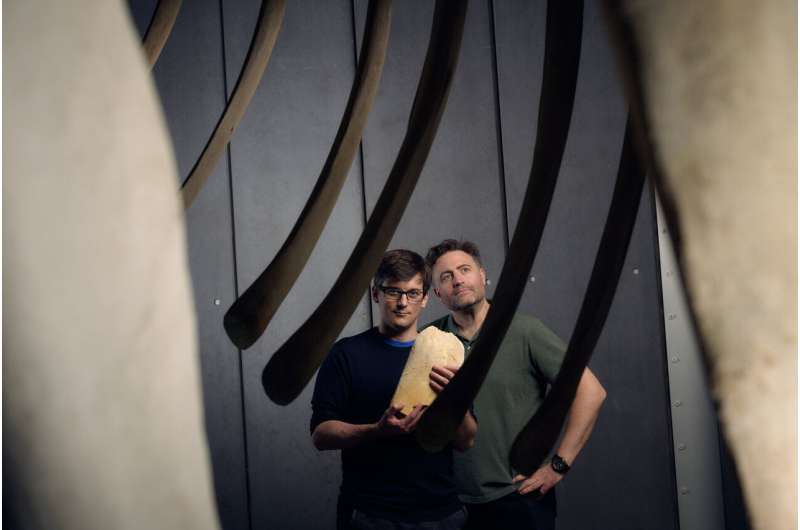
New research from the Museums Victoria Research Institute has turned upside down our previous understanding of the evolution of the largest animals ever––baleen whales.
Paleontologists Dr. James Rule (Monash University and Natural History Museum, London) and Dr. Erich Fitzgerald (Museums Victoria Research Institute) have co-authored the open access paper “Giant baleen whales emerged from a cold southern cradle,” published in the journal Proceedings of the Royal Society B.
Until now, it was believed that the beginning of the Ice Age in the Northern Hemisphere about 3 million years ago kickstarted the evolution of truly gigantic baleen whales.
The new findings reveal that in fact this evolutionary leap in size happened as early as 20 million years ago and at the polar opposite, in the Southern Hemisphere.
The major discovery came from research into a fossil cared for in the Museums Victoria collection—the front end of the lower jaw of an unusually large and ancient whale aged between 21–16 million years old. The fossil was recovered from a cliff face on the bank of the Murray River in South Australia in 1921 but was largely unrecognized in the collection until Dr. Fitzgerald realized its significance about a decade ago as the largest baleen whale known to be alive at that time.
In the paper, Dr. Rule and Dr. Fitzgerald working with a team from Australia and New Zealand show how whales evolved into gigantic sizes first in the Southern Hemisphere, not the Northern, and have had larger body sizes in the South for their entire evolutionary history—some 20–30 million years.
The new findings underscore the vital importance of the Australian and wider Southern Hemisphere fossil record for piecing together the global picture of whale evolution. The previous ruling hypothesis was based on fossils primarily found in the Northern Hemisphere, but the Murray River whale fossil disrupts that theory.
“The Southern Hemisphere, and Australia in particular, have always been over-looked frontiers for fossil whale discovery,” explains Dr. Fitzgerald. “Fossil whale finds in the South, like the Murray River whale, are shaking up the evolution of whales into a more accurate, truly global picture of what was going on in the oceans long ago.”
In their research Dr. Rule and Dr. Fitzgerald discovered that the tip of the baleen whale jaw is scalable with body size. They estimated the length of this baleen whale to be around 9 meters.
“The largest whales alive today, such as the blue whale, reach the length of a basketball court,” says Dr. Rule. “Around 19 million years ago the Murray River whale, at 9 meters long, was already a third of this length. So, baleen whales were well on their way to evolving into ocean giants.”
Factors including the great freezing of Antarctica, changes in ocean currents, and explosion of plankton biomass drove the evolution of colossal whales in the South long before they reached their huge size in the Northern Hemisphere.
Home to Australia’s largest collection of whale fossil specimens, the Museums Victoria Research Institute is at the forefront of whale evolution research and plans are already underway for research into other whale fossil items in the collection.
An ongoing flagship project, Raising Leviathan, is focused on whale evolution and includes plans to involve the local community of citizen scientists in extracting the largest ever fossil found in Melbourne, an as-yet unidentified species of whale, located in Beaumaris.
“Today’s revelation from Museums Victoria Research Institute and our partners reshapes whale evolution history, affirming our commitment to world-leading research. The Murray River fossil highlights our institute’s role in solving real-world problems, contributing new knowledge, and leading in whale evolution research,” said Lynley Crosswell, CEO of Museums Victoria.
The Melbourne Museum—the only place in Australia that presents the overarching story of whale evolution—is home to an articulated skeleton of a Blue Whale, a species of baleen whale and the largest species of animal to ever live. Visitors are invited to learn about the chronicle of whale evolution as part of general entry to Melbourne Museum.
More information:
James P. Rule et al, Giant baleen whales emerged from a cold southern cradle, Proceedings of the Royal Society B: Biological Sciences (2023). DOI: 10.1098/rspb.2023.2177
Provided by
Museum Victoria
Citation:
New research rewrites our understanding of whale evolution (2023, December 24)
retrieved 24 December 2023
from https://phys.org/news/2023-12-rewrites-whale-evolution.html
This document is subject to copyright. Apart from any fair dealing for the purpose of private study or research, no
part may be reproduced without the written permission. The content is provided for information purposes only.

